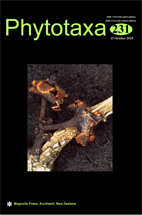Abstract
Recent molecular studies (Greenberg & Donoghue 2011, Dillenberger & Kadereit 2014) clearly demonstrated that the genus Minuartia Linnaeus (1753: 89) (Caryophyllaceae Juss.) is highly polyphyletic and the taxa previously placed in that genus (e.g., McNeill 1962, Halliday 1993) represent several distinct phylogenetic lineages less related to each other than to some other readily recognized Caryophyllaceae genera. As a consequence, many taxa, which were earlier treated in Minuartia, should be now placed in several distinct genera. Dillenberger & Kadereit (2014) proposed to recognize within the former Minuartia s.l. several genera which are supported by both morphological and molecular characters. Three genera, Mcneillia Dillenberger & Kadereit (2014: 83), Minuartiella Dillenberger & Kadereit (2014: 84), and Pseudocherleria Dillenberger & Kadereit (2014: 84), were described as new ones. Resurrection and re-circumscription was proposed for previously neglected genera Cherleria Linnaeus (1753: 425), Facchinia Reichenbach (1841: 63), Mononeuria Reichenbach (1841: 118), Rhodalsine J. Gay (1845: 25), Sabulina Reichenbach (1832: 24), and Triplateia Bartling (1830: 305), as well as re-circumscription of Minuartia sensu stricto and Eremogone Fenzl (1833: 13). A key to the new proposed classification and a nomenclatural synopsis of the currently recognized species were provided as well (Dillenberger & Kadereit 2014). Accordingly other authors already validated additional nomenclatural combinations in Eremogone (Rabeler & Wagner 2015), Mcneillia (Bartolucci et al. 2015), and Sabulina (Iamonico 2014).

